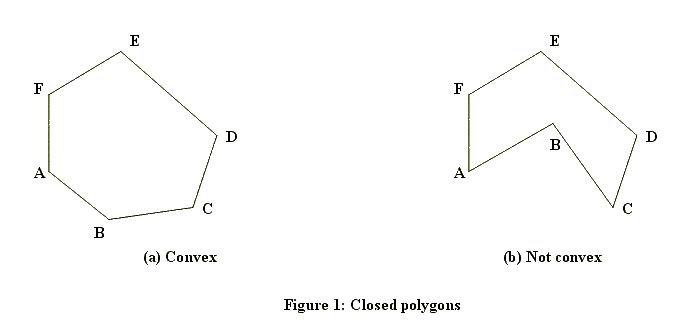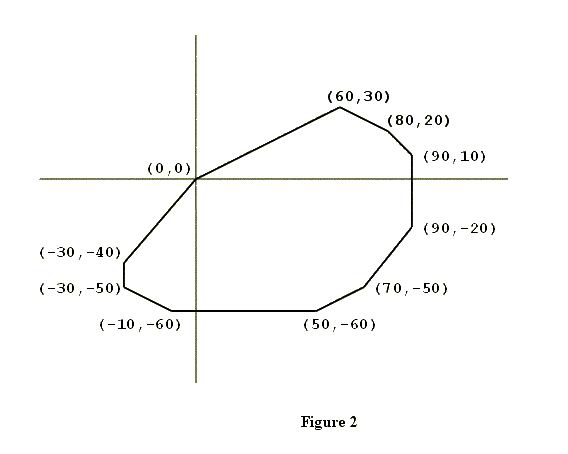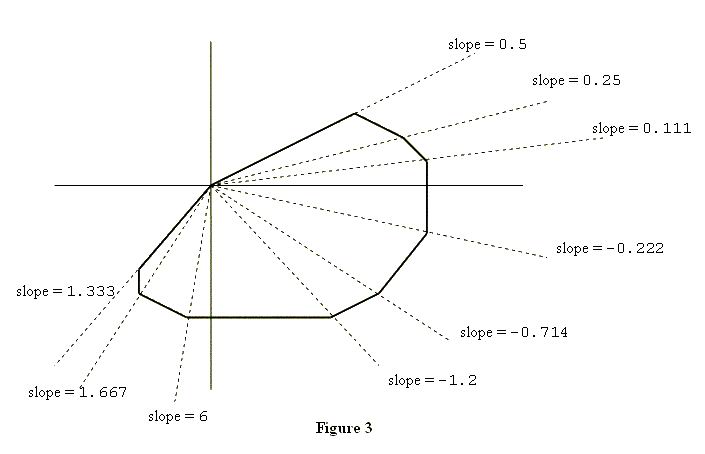POJ-2007 Scrambled Polygon(计算几何)
来源:互联网 发布:颐 文学网络 编辑:程序博客网 时间:2024/05/29 14:05
Scrambled Polygon
Time Limit: 1000MS Memory Limit: 30000KTotal Submissions: 8217 Accepted: 3903
Description
A closed polygon is a figure bounded by a finite number of line segments. The intersections of the bounding line segments are called the vertices of the polygon. When one starts at any vertex of a closed polygon and traverses each bounding line segment exactly once, one comes back to the starting vertex.
A closed polygon is called convex if the line segment joining any two points of the polygon lies in the polygon. Figure 1 shows a closed polygon which is convex and one which is not convex. (Informally, a closed polygon is convex if its border doesn't have any "dents".)

The subject of this problem is a closed convex polygon in the coordinate plane, one of whose vertices is the origin (x = 0, y = 0). Figure 2 shows an example. Such a polygon will have two properties significant for this problem.
The first property is that the vertices of the polygon will be confined to three or fewer of the four quadrants of the coordinate plane. In the example shown in Figure 2, none of the vertices are in the second quadrant (where x < 0, y > 0).
To describe the second property, suppose you "take a trip" around the polygon: start at (0, 0), visit all other vertices exactly once, and arrive at (0, 0). As you visit each vertex (other than (0, 0)), draw the diagonal that connects the current vertex with (0, 0), and calculate the slope of this diagonal. Then, within each quadrant, the slopes of these diagonals will form a decreasing or increasing sequence of numbers, i.e., they will be sorted. Figure 3 illustrates this point.


A closed polygon is called convex if the line segment joining any two points of the polygon lies in the polygon. Figure 1 shows a closed polygon which is convex and one which is not convex. (Informally, a closed polygon is convex if its border doesn't have any "dents".)

The subject of this problem is a closed convex polygon in the coordinate plane, one of whose vertices is the origin (x = 0, y = 0). Figure 2 shows an example. Such a polygon will have two properties significant for this problem.
The first property is that the vertices of the polygon will be confined to three or fewer of the four quadrants of the coordinate plane. In the example shown in Figure 2, none of the vertices are in the second quadrant (where x < 0, y > 0).
To describe the second property, suppose you "take a trip" around the polygon: start at (0, 0), visit all other vertices exactly once, and arrive at (0, 0). As you visit each vertex (other than (0, 0)), draw the diagonal that connects the current vertex with (0, 0), and calculate the slope of this diagonal. Then, within each quadrant, the slopes of these diagonals will form a decreasing or increasing sequence of numbers, i.e., they will be sorted. Figure 3 illustrates this point.


Input
The input lists the vertices of a closed convex polygon in the plane. The number of lines in the input will be at least three but no more than 50. Each line contains the x and y coordinates of one vertex. Each x and y coordinate is an integer in the range -999..999. The vertex on the first line of the input file will be the origin, i.e., x = 0 and y = 0. Otherwise, the vertices may be in a scrambled order. Except for the origin, no vertex will be on the x-axis or the y-axis. No three vertices are colinear.
Output
The output lists the vertices of the given polygon, one vertex per line. Each vertex from the input appears exactly once in the output. The origin (0,0) is the vertex on the first line of the output. The order of vertices in the output will determine a trip taken along the polygon's border, in the counterclockwise direction. The output format for each vertex is (x,y) as shown below.
Sample Input
0 070 -5060 30-30 -5080 2050 -6090 -20-30 -40-10 -6090 10
Sample Output
(0,0)(-30,-40)(-30,-50)(-10,-60)(50,-60)(70,-50)(90,-20)(90,10)(80,20)(60,30)
/*
题目大意:乱序给出一个凸多边形的顶点坐标,让你逆时针输出这些顶点,第一个顶点一定是(0,0)
思路:根据叉积的定理:
a X b 为有向面积,可正可负。若a逆时针旋转小于180度可到b,则结果为正,否则结果为负
所以,叉积大于0,则前一个向量可以逆时针旋转小于180度得到第二个向量
*/
#include<iostream>#include<cstdio>#include<cmath>#include<algorithm>using namespace std;struct Vector{ double x,y; Vector(int xx,int yy):x(xx),y(yy){} Vector(){} double operator ^ (const Vector & v)const { return x*v.y - y*v.x; }};#define Point Vector//从p2指向p1Vector operator - (const Point & p1,const Point & p2){ return Vector(p1.x-p2.x,p1.y-p2.y);}//利用定理:叉积大于0,则前一个向量可以逆时针旋转小于180度得到第二个向量bool operator < (const Point & p1,const Point & p2){//先将点转化为向量 if((Vector(p2-Point(0,0)) ^ Vector(p1-Point(0,0)))>0) return true; return false;}Point ps[55];int main(){ int n = 0; //while(scanf("%lf%lf",&ps[n].x,&ps[n].y) != EOF) while(cin>>ps[n].x>>ps[n].y) n++; sort(ps+1,ps+n); printf("(0,0)\n"); for(int i = n-1;i > 0;i--) printf("(%.0f,%.0f)\n",ps[i].x,ps[i].y); return 0;} 0 0
- poj 2007 Scrambled Polygon(计算几何)
- POJ-2007 Scrambled Polygon(计算几何)
- POJ 2007 Scrambled Polygon(几何)
- POJ 2007 Scrambled Polygon(计算几何 叉积排序啊)
- [POJ2007]Scrambled Polygon(计算几何)
- poj--2007--Scrambled Polygon(数学几何基础)
- 计算几何:极角排序(poj 2007 Scrambled Polygon)与简单凸包(poj 1113 Wall)
- 哈理工OJ 1305 /POJ 2007 多边形 Scrambled Polygon【计算几何】【极角排序】
- poj 2007 Scrambled Polygon
- poj 2007 Scrambled Polygon
- POJ 2007 Scrambled Polygon
- POJ 2007 Scrambled Polygon
- POJ 2007 Scrambled Polygon
- POJ 2007 Scrambled Polygon
- POJ 2007 Scrambled Polygon
- poj 2007 Scrambled Polygon
- POJ 2007 Scrambled Polygon .
- POJ 2007 Scrambled Polygon
- HDU 4576(概率DP+滚动数组)
- C#使用Unity框架
- pyqt 修改line Edit的背景颜色
- c++ fstream中seekg()和seekp()的用法
- 十、外观模式Facade(结构型)
- POJ-2007 Scrambled Polygon(计算几何)
- JDK源码学习(1)-HashMap源码分析,HashMap与HashTable的差别
- 进程间通信——mmap()函数
- [HDU5739] Fantasia [2016 Multi-University Training Contest 2(多校联合训练2) F]
- noip2013提高组day201积木大赛
- 解决 Android Studio Gradle 慢的方法
- Red and Black(基础DFS)
- 生活、工作点滴(序)
- poj 1952 BUY LOW, BUY LOWER【解法一】


